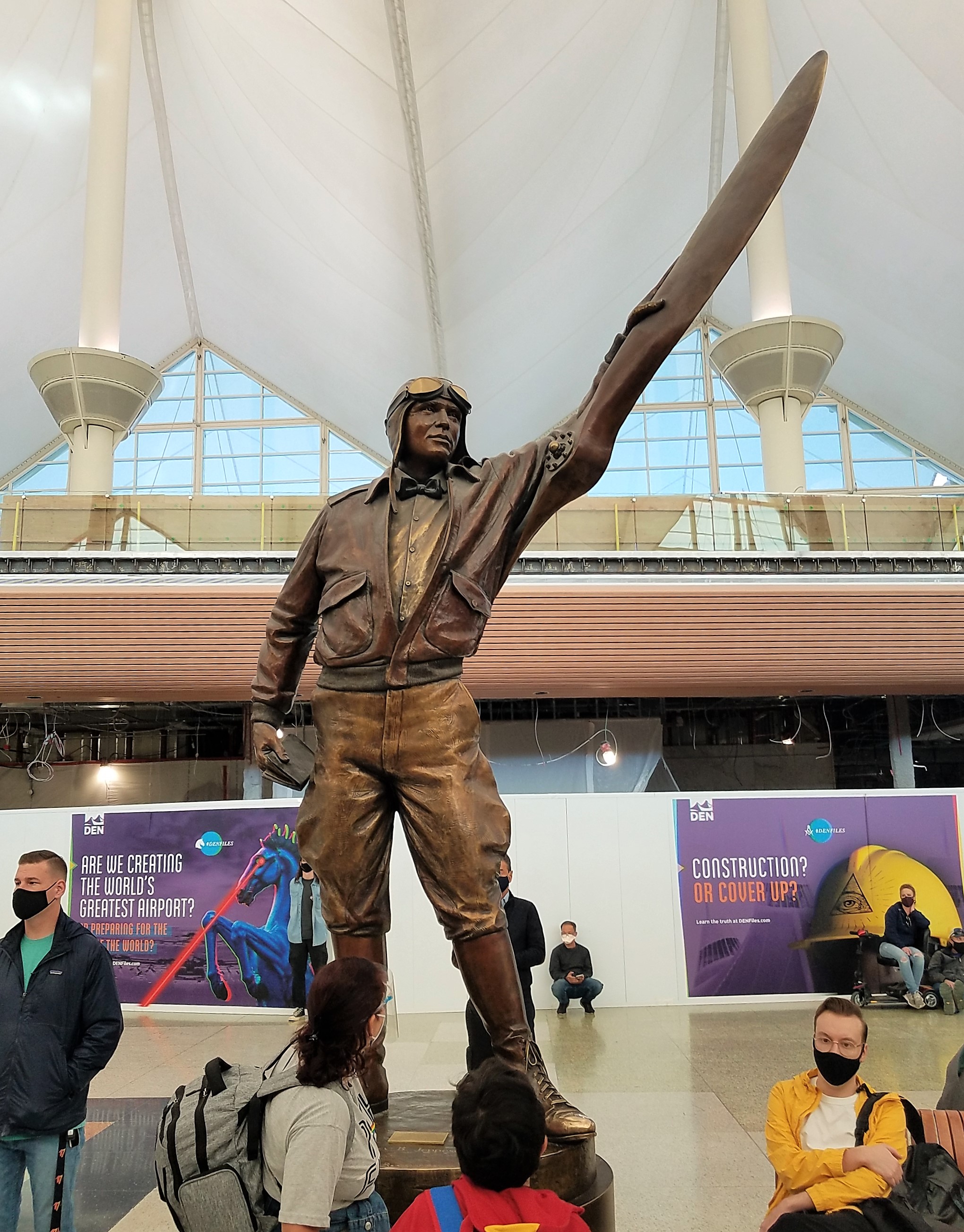This statue of Elrey Jeppesen (1907 – 1996) stands in the center of level 5 of the Elrey Jeppesen main terminal at Denver International Airport (DEN). George Lundeen created this bronze tribute to Jeppesen in 1994. It has greeted travelers passing through DEN since the airport opened in 1995.
The 16-foot (4.9 m) sculpture depicts Jeppesen holding an aircraft propeller pointing to the skies. Unless you look closely, the propeller appears to be part of Jeppesen’s body. From a distance, the statue reminds me of the shape-shifting terminator cop in the movie The Terminator 2: Judgement Day.

Jeppesen was an American aviation pioneer who devised and published manuals and charts that enabled pilots to fly much more safely. In 1930, Jeppesen joined Boeing Air Transport as an airmail pilot and quickly recognized that pilots needed better information on navigation and landing in bad weather.
In 1934, he founded the Jeppesen Company. The company, headquartered in Englewood, Colorado, sells a variety of pilot aids including charts and instrument approach plates containing navigational information, airport diagrams, and radio frequencies, flight planning products and software and many other products that continue to be widely used by private and professional pilots. The company is now owned by Boeing.
Wikipedia describes Jeppesen’s contributions:
While airway beacons assisted aerial navigation on specific routes, most pilots at that time depended on dead reckoning, generally using automobile road maps (such as those from oil companies or commercial mapmakers), railroad tracks and landmarks to find their way. Jeppesen purchased a ten-cent notebook and started writing down detailed notes about his routes. He even climbed hills to determine their height and collected telephone numbers of farmers willing to provide weather reports. Word got around about his “Little Black Book”, and soon he was giving copies to his fellow pilots. Jeppesen was the first to design enroute procedures, let down procedures, approach procedures, and the all-important, missed approach procedure. If the weather was bad and the visibility went to zero, the pilot could fly the missed approach procedure and survive. The Jeppesen Airway Manual had a missed approach procedure for that airport so the pilot knew what heading to turn to and miss the mountains and how high to climb. Today, all airlines use the Jeppesen Airway Manual for navigation. Citations omitted.
Below are photos of a Jeppesen airport diagram and ILS approach procedure for Cincinnati Lunken Airport, my former hometown general aviation airport. The plates contain a wealth of information needed for flying safely. There are similar charts for every airport and instrument approach in North America and many countries around the world.
These charts and information are also available digitally. Jeppesen’s Little Black Book has come along way. Pilots are grateful.
Sculpture Saturday is a challenge hosted by Susan Kelly at No Fixed Plans.




yes! very Terminator!
LikeLiked by 1 person
He’ll be back!!!
LikeLike
that is a cool sculpture, and I can see the Terminator comparison…
LikeLiked by 1 person
It is a strange statue.
LikeLiked by 1 person
I never heard of Jeppeson before. Yes, he made an essential contribution to aviation. He deserves to be honored like this.
Thanks for joining.
LikeLiked by 1 person
I’m glad I stopped to investigate the statue.
LikeLike
Wow! That’s incredible.
LikeLiked by 1 person
I agree.
LikeLike